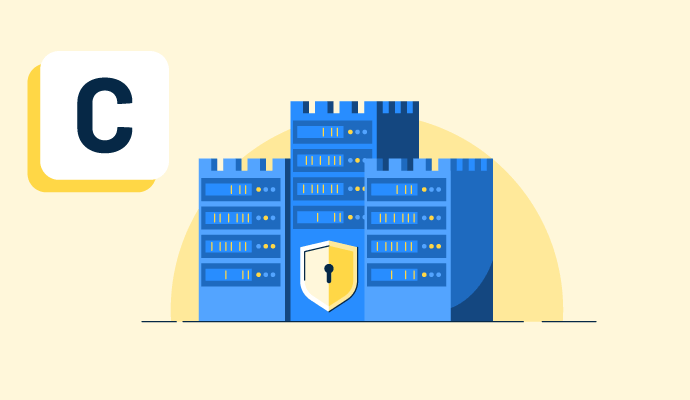What is cybersecurity?
Cybersecurity refers to actions taken to combat threats against networked systems and applications, regardless of where the threat originates. It’s described by the National Institute of Information Technology (NIIT) as safeguarding, avoiding harm to, and reestablishing electronic communications services and systems.
Vast volumes of data are maintained on networks and computer systems. This applies to almost every industry. Many organizations use website security software to protect their websites and applications against cyber threats.
Cybersecurity focuses on everything pertaining to electronic systems and communications. Within the field of cybersecurity, some subcategories call for additional specialization. These cover network, critical infrastructure, and cloud security.
Types of cybersecurity
Cybersecurity is applicable in various contexts, but a few of the standard categories are described below.
- Network security protects a computer network from intruders such as deliberate hackers or malicious software.
- Application security is concerned with preventing attacks from infectious software and hardware. A compromised application might give access to the data it’s supposed to protect. Security starts at the design stage, even before a program is deployed.
- Data integrity and privacy are safeguarded through information security when data is stored and transported.
- Operational security includes procedures and choices that manage and safeguard data assets. All the policies control how and where data is stored or exchanged, as well as the permissions users have while accessing a network.
- Disaster recovery and business continuity determine how a business reacts to a cyber attack or any other situation that results in operations breakdown. Disaster recovery procedures specify how the organization restores its operations and resumes normal business operations. When certain resources are not available, the organization's backup plan maintains continuity.
- End-user education deals with the most unpredictable aspect of cybersecurity: people. Anyone who ignores good security practices runs the risk of accidentally transmitting a virus into an otherwise protected system. For any firm’s security, it’s crucial to teach users how to avoid exposing the network’s vulnerabilities.
Cybersecurity benefits
Cybersecurity protects organizations from fraud and threats, but those aren’t its only benefits. Cybersecurity also:
- Protects against external threats. A strong cybersecurity posture that regularly updates software helps organizations detect and respond to cyber attacks.
- Prevents internal breaches. Human error remains cybersecurity’s weakest link. Insider threats can originate from current or former employees, third-party vendors, or even trusted partners. These risks can be unintentional, careless, or downright malicious. Proactively monitoring networks and managing access helps identify dangers to deal with them before they become expensive incidents.
- Complies with regulatory standards. Numerous regulatory authorities have guidelines to protect businesses and their clients in response to the growing cyber dangers and disclosure of sensitive data. Critical legal standards include the Health Insurance Portability and Accountability Act (HIPAA) and the Payment Card Industry Data Security Standard (PCI DDS).
- Prevents work stoppage. Viruses and cyberattacks slow down networks and personal devices. They make it nearly impossible for employees to work, for websites to function, or for businesses to operate. Businesses can implement several cybersecurity measures to drastically reduce violations and downtime required to fix breaches with improved firewalls, regular virus scans, and automated backups.
- Lowers costs. Mitigating risk puts a company in a better position to retain current clients after a breach, which is significantly more cost-effective than finding new ones.
- Develops brand trust. Keeping customers and upholding a good reputation is crucial to business growth. A strong cybersecurity stance is a fast route to customer referrals, repeat business, and increased per-ticket spending. It also helps retailers get on the vendor list with bigger companies as a part of their supply chain. This opens possibilities for expansion.
Cybersecurity best practices
Organizations must implement good cybersecurity technologies and best practices to reduce cyber attack vulnerability and protect vulnerable confidential data. Below are some of the best practices to follow.
- Adopt identity and access management (IAM) that describes each user's roles and access privileges. IAM methodologies offer users single sign-on, so they don’t have to re-enter credentials during the same session. Two-factor authentication requires two access credentials, privileged user accounts, and user lifecycle management.
- Onboard diverse data security platforms to safeguard confidential information in various settings, including hybrid and multi-cloud environments. Data security platforms provide automated, real-time visibility of risk areas and warn users about vulnerabilities before a breach becomes inevitable.
- Equip security information and event management systems (SIEM) with the means to analyze data and automatically detect suspicious activities. SIEM solutions now have sophisticated detection techniques like artificial intelligence and user behavior analytics.
Cybersecurity threats
Cyber attacks grow more sophisticated as time passes, and several common practices are still used today.
- Malware is software designed to illegally gain access to or cause damage to a system.
- Phishing occurs when fraudulent emails are sent to a user to steal sensitive data or attack a system. The emails resemble mail from secure sources, which makes it easy to trick targets.
- Ransomware is malicious software that extorts money from users by blocking access to the system.
- Social engineering is used by cybercriminals to trick users into revealing confidential data or information.
- SQL injection takes control of a system and steals data from the database.
- Machine-in-the-middle attack refers to when a cybercriminal intercepts communication between two users to hack their information.
Cybersecurity vs. information security
Cybersecurity and information security are often considered identical. They do overlap in some ways, but information security and cybersecurity are two different career areas, and they feature distinct specialties and need different skill sets.
Cybersecurity deals with protecting digital assets from any kind of cyber threat, while information security protects data from all kinds of threats. Data is safeguarded from unauthorized users to ensure confidentiality, integrity, and availability.
Professionals in cybersecurity prevent active threats or advanced persistent threats (APT). Information security specialists focus on data security; they oversee the organizational roles, processes, and policies that guarantee safe data.
Cybersecurity deals with digital assets only, whereas information security also includes the security of printed information.
Learn more about information security and understand why it’s crucial for protecting data.

Sagar Joshi
Sagar Joshi is a former content marketing specialist at G2 in India. He is an engineer with a keen interest in data analytics and cybersecurity. He writes about topics related to them. You can find him reading books, learning a new language, or playing pool in his free time.





















